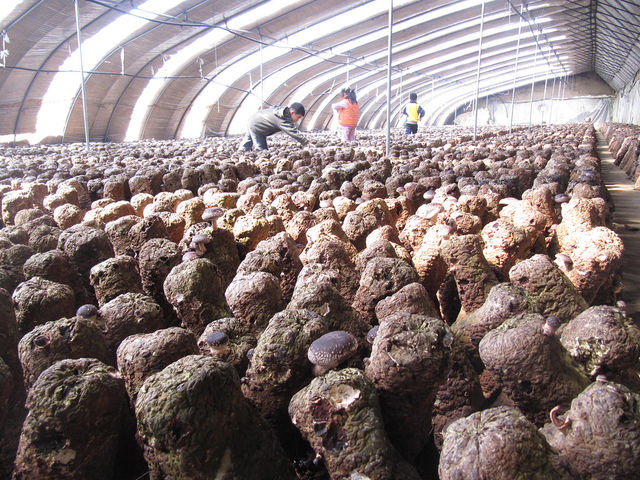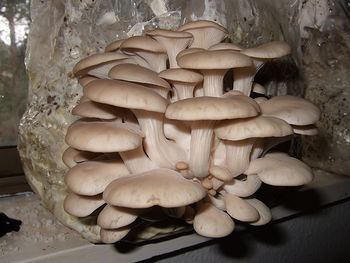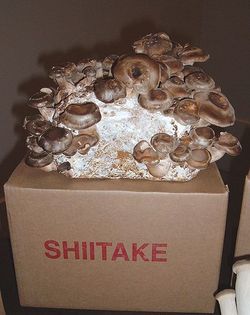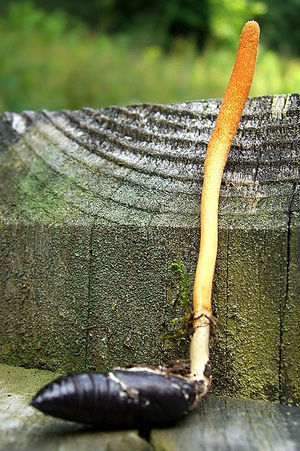Mushrooms
Main > Food and Agriculture > Controlled-environment growing
Mushrooms are the reproductive organs and the only visible part of fungi. The fungus organism consists mostly of mycelium, which is a web of very fine strands that stretch invisibly through the soil. The mycelium lives perennially and only produces mushrooms under certain conditions of humidity, light etc.
Mushrooms can fetch quite a high price compared to other foodstuffs, so their cultivation can be quite lucrative. Some edible mushrooms have shown impressive health benefits in studies and many help prevent cancer. Oyster mushrooms (shown to the right) hold a lot of promise for economic development; they grow aggressively in all kinds of substrates, including cardboard. By growing oyster mushrooms, you can transform old cardboard into delicious, valuable, cancer-fighting food.
Open-source mushroom growing
Outdoor growing
On a farm, mushrooms can provide delicious food with medicinal benefits while decomposing logs, grass, grain and other organic matter, sometimes including substances toxic to most other organisms, such as oil. Growing beneficial mushrooms also makes it harder for parasitical fungal blights to get a foothold. Sawdust, grain husks, wood chips, logs and manure generated on the farm can be used to grow mushrooms. You can grow mushrooms either on logs or else in beds of wood chips, depending on the species.
- Oyster mushrooms, pleurotus ostreatus are by far the easiest mushrooms to grow, and among the most nutritious, with 15-30% protein content. They adapt to a huge range of substrates: grain husks (an opportunity here for farms growing grains!), straw, logs, or old shredded paper. After harvest, some of the substrate can then be taken out and surrounded with fresh substrate, allowing you to grow the colony. They have even successfully been grown on petrol and can therefore be used in turning spilt oil from a pollutant into a highly nutritious and beneficial substance.
- Shiitake, lentinula edodes can be grown on dead logs of oak, willow, birch, beech, alder, ironwood, eucalyptus and other broadleaf trees. A log, once inoculated with spawn, can continue to fruit for 3-6 years. The logs should not be in contact with the ground; they can be stood upright and their foot wrapped in a polyethylene bag, or they can be suspended on blocks. They will fruit at temperatures of around 10-26°C (50-80°F). See Shiitake Mushroom Production on Logs (link is to a 34-page pdf file). Shiitake mushrooms have demonstrated anticancer, antibacterial and antiviral properties in trials and are delicious.
- Pioppino, Agrocybe aegerita can be in warm, humid climates. Culture the mycelium in sawdust. Bore holes into logs of hardwood trees like willow, poplar and maple and pack the sawdust in. Leave the logs lying half-buried. It is an excellent mushroom to use to recycle logs and a very tasty food.
- Enokitake, Flammulina velutipes will survive very cold temperatures and can be grown in shredded paper or tree stumps. Fruits in winter. This mushroom has well-documented anticancer properties. The utmost caution should be taken not to confuse it with conocybe or galerina fungi, which look similar and are deadly poisonous. Even when you have inoculated a log with enokitake, some native poisonous mushrooms can still grow there. Look at the gills (the underside of the cap) to tell; enokitake gills are white, whereas galerina and concybe have brown gills.
- Reishi, ganoderma lucidum is one of the most powerfully medicinal mushrooms. It grows natively over a broad area from the Amazon through North America and across much of Asia. It is hardy and easily grown. Drill holes in a log of any kind of tree and insert the cultured spawn into the holes.
- Maitake, grifola frondosa grows in temperate regions, including the temperate forests of North America. Evidence suggests that they lower blood glucose and have anticancer and immunostimulatory properties. Colonize logs or stumps by drilling holes and plugging them with spawn, then bury the logs. They will fruit in September and October.
- Lion's Mane, hericium erinaceus can be grown on inoculated logs of oak, beech, elm, walnut and other trees. Research has found that they cause an increase in Nerve Growth Factor. Eating these literally gives you more brains.
- Elm oyster, hypsizygus ulmarius can be grown by spreading mycelium in a vegetable patch and covering with sawdust mulch. It acts symbiotically with vegetable roots and encourages their growth.
- Chaga, inonotus obliquus can be inoculated into dead or dying birch, beech, oak and ironwood trees. Chaga is consumed as a bitter tea and has considerable antitumor properties.
- King oyster, pleurotus eryngii is a gourmet mushroom. It can be grown on half-buried logs. It fruits in spring and summer in the Mediterranean region. According to Mycelium Running, it breaks down toxic dioxins in the environment.
- Garden giant, stropharia rugosoannulata, is a huge red mushroom native to Europe, New Zealand, Japan and the Atlantic coast of the US. Can be grown by scattering inoculated sawdust into a raked bed of wood chips or straw. It attracts earthworms and purges coliforms from soil.
- Turkey Tail, trametes versicolor is a shelf mushroom that grows all over the world from the tropics to boreal forests. It has well-documented anticancer properties and is possibly the most powerful of all the cancer-fighting mushrooms. It can be grown on any hardwood tree in exactly the same manner as reishi. A single log can grow both reishi and Turkey Tail. Growing Turkey Tail in an agroecosystem is a good way to outcompete parasitic blight fungi.
Indoor growing
This section is a stub
Growing indoors allows you to grow a greater variety of mushrooms than you could outdoors. The main advantage is rapid, constant, year-round yield. By growing indoors, you can grow ten harvests a year instead of one.
It can be recommended to buy the mycelium instead of growing it. This will ensure a better harvest (contrary to no harvest at all), as growing mycelium tends to require more expertise than growing the mushrooms.
Overview
Growing mushrooms indoors involves the following steps -
- First, inoculate sterile agar with mushroom spores. Incubate the agar for a few days to allow mycelium to grow. (You can skip this step if you are starting with mycelium rather than spores.)
- Next, prepare the substrate. This involves sterilizing the substrate, often by boiling it in a pot or pressure cooker. This is done to kill other bacterial and fungal species that would compete with the mycelium you are trying to grow.
- Now isolate the mycelium from the agar and put it onto your sterile substrate.
- The next step is to allow the mycelium to spread through the substrate. This is done by incubating it in a dark place. This simulates the mycelium expanding through soil, as would happen in nature. When the substrate is completely covered in mycelium, you are ready to get it to sprout mushrooms.
- The next step is called 'casing'. This means covering the substrate with a thin layer of soil or something similar. This makes the mycelium think it is slightly underground, which encourages it to grow mushrooms.
- Now move the substrate into the fruiting conditions. These conditions vary from species to species, but usually you need to increase humidity and CO2 concentration and exposing them to light. This simulates the season at which mushrooms appear in outdoor growing.
- Harvest your mushrooms! Wear a mask before and during the harvesting, as spores can cause astma and allergies that are (so far) not curable.
- Take spore prints or samples of mycelium from the mushrooms so you can repeat the process.
Mushroom Growing Supplies
- Mushroom Substrates
- Mushroom Substrate Additives
- Mushroom Mycology Supplies
- Mushroom Cultures
- Laboratory Supplies
Equipment
- Alcohol-burning lamp or bunsen burner. Instructables alcohol burner.
- Scalpel and inoculating loop.
- Potato Dextrose Yeast Agar or Malt Extract agar.
- Mask to protect from spores.
Small-scale growing
- Glovebox. Get a large plastic box. Cut two holes in. Duct-tape rubber kitchen gloves into the holes. This serves as a miniature sterile lab where you can do inoculation and other sterile work.
- Pressure cooker to sterilize the substrate.
- Terrarium for fruiting the mushrooms can be made from an old aquarium or any box that lets light in. Wet perlite at the bottom will provide humidity.
- Testing to add information from the mushroom learning network
Medium-scale growing
- A broken refrigerator makes an excellent chamber to incubate mycelium (step 4 above). It is dark, well-insulated and, most importantly, is sealed against contaminated air.
- A small room or closet with an antechamber. Remove all carpets, fabrics, and other porous material that could harbour contaminants,
- Laminar flow hood. [1]
Large-scale growing
The basic challenge is to build a room that can easily be kept sterile to avoid contamination and is equipped for measuring and controlling levels of light, carbon dioxide, humidity and temperature. The room needs to have a controlled air supply which can be sterilized and humidified.
Use mosquito net to keep flies away on all doors and windows, and sticky tapes or other methods to capture flies that have gotten in. Keep the room and material thoroughly clean, as problems often come more from the inside than the outside.
ArkFab are working on Spore v.2 an open-source mushroom grow house made of shipping containers. Their design (here) is projected to grow 80lb (36kg) of mushrooms per week.
- Cheap, open-source humidity sensor
- CO2 sensor. It would be nice to get this open-sourced. Useful for greenhouse growing in general.
- Ultraviolet lamps might be a more cost-effective way to sterilize incoming air than HEPA filters. The duct should be lined with mirrors to maximise the use of the UV rays [2]
- Equipment to humidify the room. Depending on budget and local climate different solutions are possible here, water-curtains, mystifiers, etc.. Do not drip onto the products.
Substrates
- Vermiculite
- Straw - works good in warmer climate conditions.
- Coffee grounds - an excellent component , the caffeine will enhance mushroom growth. Coffee grounds absorb the water well.
- Grain husks - spent grains ex-breweries will need to be rinsed to remove all sugars they still contain. Use about 40% of spent grains only. Take care of keeping right pH levels.
- Weird ones
Mushrooms
- Psilocybe genus. These are illegal to cultivate and sell in most countries. Spores are generally legal to possess, except in California, Georgia, Idaho and Germany [3]. They are harder to grow than most mushrooms, and are especially sensitive to contamination; you need to be very careful to keep the environment sterile. Usually grown by inoculating spores into rye grain or cakes made from brown rice flour.
- Shiitake mushrooms can be grown without the need to control CO2 levels. This would reduce start-up costs. Logs of hardwood, such as oak, can be used as a substrate.
- Oyster mushrooms can be grown on cardboard that has been sterilized by boiling it. See here for instructions.
- Cordyceps sinensis can fetch $10-20 a gram. Only a few people have managed to grow it successfully.
Other uses of mushrooms
Enhancing plant growth
The mycelium of fungi often form a symbiotic unit called a mycorrhiza with a plant root. The Elm oyster mushroom, hypsizygus ulmarius can be grown in vegetable patches and is said to significantly increase yields.
The plant roots provide the mycelium with sugars, and the mycelium provides the roots with water and minerals in a bioavailable form.
Mycelial strands are only one cell thick, much thinner than any root, and so can reach smaller spaces in the soil to extract nutrients. And mycelium excretes enzymes that plants cannot, breaking down soil nutrients into bioavailable forms.
In addition, beneficial fungi around a plant's roots stop pathogenic fungi from forming there.
Mycoremediation
For background, please see Appropedia page. Mycoremediation practices involve mixing mycelium (the vegetative part of a fungus) into contaminated soil, placing mycelial mats over toxic sites, or a combination of these techniques, in one or more treatments. The lead researcher in this field is mycologist Paul Stamets. The information presented in this document comes from his book "Mycelium Running -How Mushrooms Can Save the World" (see: Piratebay: Mycelium Running).
Fungi were the first form of life to leave the sea and colonize the land. They prepared the earth for other life to flourish back then - and they can do it again. The role of mushrooms in the ecosystem is as pioneers; different mushrooms secrete a vast range of enzymes that can digest just about anything, including rock, toxins, pollutants, crude oil and chemical warfare agents.
Bioplastics
See Moldable mycelium for OSE project information.
The mycelium of certain species of mushrooms can turn grain husks into useful materials. 'Greensulate' is a low-impact alternative to styrofoam made from rice hulls digested by oyster mushroom mycelium.
Mushroom Leather
Mushroom leather (or "Myco-leather") is an alternative to animal leather that resembles suede but is softer. It is a fully biodegradable material that is easily shaped and tanned. Mushroom leather can be produced as a composite, for example using hemp fibers for improved strength (example: "Myx").
Insecticide
This section is a stub
Pioneering mycologist Paul Stamets has patented a technique of using metarhizium spores to repel termites, carpenter ants and other such social insects. The fungus infects these insects, and the insects know it and stay away from any area where the spores are present.
- http://en.wikipedia.org/wiki/Entomopathogenic_fungus
- http://www.scitopics.com/Ecology_of_entomopathogenic_fungi_in_agroecosystems.html
Biofuel
This section is a stub
Mushrooms can convert cellulose to ethanol
Water filtration
This section is a stub
Put colonized bags in a stream and they can not only filter out hydrocarbons like benzene, but turn them into valuable food.
Bags of King Stropharia (stropharia rugosoannulata) will filter coliform bacteria out of water streams coming from cattle-feeding operations.
Links
Open Source Mycology
- Motherboard talking Shrooms with Peter McCoy - http://motherboard.vice.com/blog/the-radical-power-of-shrooms-talking-radical-mycology-with-peter-mccoy].
Sources
- Fungi.com - This site sells all kinds of mushroom growkits. They have developed a method of filling little wooden plugs with spores. 30-50 of these plugs ($3-5) can be stuck in a short log so that the mycelium completely colonize the log. Buy them here. They also sell indoor growkits including shiitake, oyster, reishi, maitake and Lion's Mane mushrooms, all for about $26 - meaning you'd break even if you grew 4lbs
- Bemushroomed - an online community gene bank where you can get spores and spawn for free through the generosity of other growers.
Instructional
- The Shroomery is a great, very educational website, focused mostly, but not entirely, on psilocybin mushrooms. There is a thriving forum community full of people who know a thing or two about mushrooms. The forum includes a board on edible and medicinal mushrooms. You can get free cultures there if you ask nicely.
- 12 gig torrent on permaculture, includes a folder of material from mushroom man Paul Stamets, and two instructional video series on growing mushrooms.
- Growing Gourmet And Medicinal Mushrooms and The Mushroom Cultivator books by Paul Stamets. Various techniques for cultivating different kinds of mushrooms.
- Arkfab are developing open-source hardware for growing mushrooms. Watch this space.
Other
- Paul Stamets on 6 ways mushrooms can save the world - TED video - Mycologist Paul Stamets lists 6 ways the mycelium fungus can help save the universe: cleaning polluted soil, making insecticides, treating smallpox and even flu.



